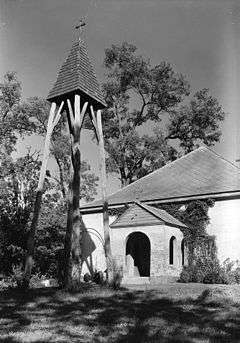Broad Creek, Prince George's County, Maryland
|
Broad Creek Historic District | |
|
Broad Creek Church | |
  | |
| Nearest city | Friendly, Maryland |
|---|---|
| Coordinates | 38°45′28″N 76°59′49″W / 38.75778°N 76.99694°WCoordinates: 38°45′28″N 76°59′49″W / 38.75778°N 76.99694°W |
| Architectural style | Georgian, Other |
| NRHP Reference # | 11000881 [1] |
| Added to NRHP | December 8, 2011 |
Broad Creek in Prince George's County was the first footprint of European settlement in the immediate counties around what would become the nation's capital, Washington, D.C. The area is part of greater Fort Washington.
The area was settled by Europeans in the 1660s and the town was created in 1706 when the colonial Maryland Legislature authorized surveying and laying out the towns of Queen Anne Town, Nottingham, Mill Town, Piscataway, Aire (also known as Broad Creek) and Upper Marlboro (then known as Marlborough Town).[2][3][4][5]
In 1747, the legislature tried to improve the quality and the method of marketing tobacco, then the major crop of the area, and established a formal system of tobacco inspection and quality control. The town was home to one of seven state tobacco warehouses built in Prince George's County.[4]
The site is located 9 miles (14 km) south of the U.S. Capitol building on the Potomac River. Today, this "first footprint" of settlement in the capital area is a Prince George's County Historic District, with three 17th century homesites and an 18th-century Episcopal Church structure. The Broad Creek Historic District comprises 900 acres (3.6 km2) along the Potomac River, and is remarkable for its environmental resources, as well as its 12,000-year-old Indian archeological discoveries.
It was placed on the National Register of Historic Places on December 8, 2011.[1]
References
- 1 2 National Park Service (2010-07-09). "National Register Information System". National Register of Historic Places. National Park Service.
- ↑ Baltz, Shirley Vlasak (1984). A Chronicle of Belair Mansion. Bowie, Maryland: Bowie Heritage Committee. pp. 4–7. LCCN 85165028.
- ↑ "African-American Sites Along the Patuxent River: Queen Anne Town". Maryland Department of Natural Resources. Retrieved 05/04/2007. Check date values in:
|access-date=(help) - 1 2 Virta, Alan (1984). Prince George's County: A Pictorial History. Norfolk, Virginia: The Donning Company. p. 40.
- ↑ Emma K. Young (September 2010). "National Register of Historic Places Registration: Broad Creek Historic District" (PDF). Maryland Historical Trust. Retrieved 2015-08-01.
External links
- Broad Creek Historic District, Prince George's County, Inventory No.: PG:80-24, including undated photo, at Maryland Historical Trust website
- Historic American Buildings Survey (HABS) No. MD-49, "Broad Creek Church, 9801 Old Oxon Hill Road, Friendly vicinity, Prince George's County, MD", 6 photos, 5 data pages, 1 photo caption page


